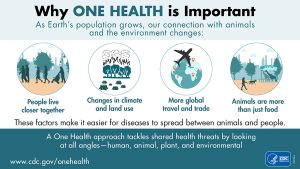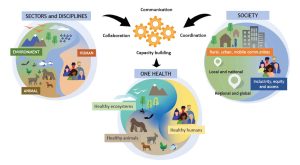Words by Dr Khilasa Pokharel
In an era where global health faces unprecedented challenges, the concept of One Health emerges as a beacon of hope, weaving together the intricate bond of human, animal, and environmental health. Dr. Khilasa Pokharel, an esteemed Microbiologist and Associate Professor at Kathmandu Medical College and Teaching Hospital, sheds light on the multifaceted nature of this integrated approach, aiming to reshape our understanding of health systems and interdependencies in the modern world.

“One Health isn’t just a concept; it’s a global necessity—connecting human, animal, and environmental health for a healthier world.”
One health is an integrated approach to balance and optimize the health of human, animals and the environment. It is a multisectoral collaborative approach that can be achieved at the local, regional, national and global levels. It carries an optimal goal by connecting human, animals, plants and the environment. One health system creates a wide range of roles and responsibilities among diverse multisectoral challenges. One health system helps us to evaluate existing system, encourages on collaboration, cooperation, teamwork across multisectoral preparedness and how to cope complex one health challenges. It includes emerging, zoonotic, neglected, vector borne diseases. Similarly, it focuses on diseases acquired from an environment such as from water, soil, air, etc. Another factor is food security and food safety.
“The strength of One Health lies in collaboration and action, weaving together sectors to combat emerging diseases and safeguard food safety.

Interconnectedness of Human, Animal, and Environmental Health
Our wellbeing is delicately interconnected with the balance between human, animal, and environmental health. They are all interconnected in ways often unseen, these three pillars of health intertwine, each influencing the others in a symphony of interdependence. Human health is intricately linked to animal health, with zoonotic diseases serving as poignant reminders of this connection, as pathogens seamlessly traverse species boundaries, posing threats to both humans and animals alike. Remember that the COVID-19 came from bats. Moreover, environmental factors play a pivotal role, shaping the health landscape by impacting air quality, water purity, and the stability of ecosystems. The health of animals and the state of our environment act as barometers, reflecting the intricate web of relationships that define our planet’s health. Understanding and nurturing this interconnectedness lie at the heart of the One Health approach, emphasizing the critical need for collaborative efforts to safeguard and promote the holistic well-being of all interconnected elements.
“Nepal’s strides in One Health underscore the critical role of governmental and international initiatives in promoting health security for all.”

As we are living in the growing and expanding population in new geographic area, people now a days live in close contact with various domestic and even wild pets. Nowadays, close contact with animals has become a leading cause for emerging disease. Health of people is somehow related with health of animals and environment. This health system aims to educate individuals and at same time it creates a network for the betterment of health outcomes and well being of humans, animals and an environment which is beneficial for collaboration. One health is useful to control zoonotic problems and against those diseases spread from an environment. Highly pathogenic diseases like avian influenza, severe acute respiratory syndrome (SARS), severe acute respiratory corona virus-2 (SARS CoV-2), Middle East respiratory syndrome (MERS) and Ebola have provided major impact on international advocacy and funding.
Climate changes, deforestation, unsustainable agricultural practices, unhandled wildlife, globalization are few factors which are creating opportunity for pathogens to evolve into new forms, forming spillover from human to animals and from animals to humans. Other issues like food safety, antimicrobial resistance, poor health management, climate changes, etc. should be addressed from multidisciplinary levels which guarantees one health approach.
Embracing One Health
One health can prevent outbreak of zoonotic diseases, by preventing spillover and it will also structure food safety and security. It will reduce antimicrobial resistance which will certainly reduce and will improve health of human, animals and an environment. One health will bring global health security, diversity and conservation. There are many challenges like non communicable diseases, antimicrobial resistance, social network, evolutionary medicine, urbanization, reservoirs, ecology, ecotoxicology, legal framework, cultural practice, human-animal-environmental relation, veterinary medicine and zoonosis. Similarly, it also includes climate changes, forest clearance and land cover change, land degradation, fresh water depletion and contamination which damage ecosystem. All of these might lead to floods, water shortages, landslides, increase exposure to ultraviolet radiation, altered infectious disease risk, reduce food yields, depletion of natural medicines, mental health, population displacement, inappropriate adaptation etc.

Strategies and Challenges in Implementing One Health Systems
Now a days countries have started to promote collaboration among human, animals and environmental factors which is required to maintain one health. Departments like ministry of health and population, department of food technology and quality control, ministry of agriculture and livestock department should be the leading department to maintain one health system effective. With growing acceptance of one health, criticism has been seen with disproportion between public health, narrow professional focus, more focus on zoonotic diseases, inappropriate environmental concept and expertise. Government has to call up dedicated expertise on the subject to promote the implementation of roadmap by prioritizing to engage different sectors on the basis of systems approach of national levels which will help to strengthen one health system. To effectively gauge the capacity and progress of One Health systems, tools facilitating coordination, planning, and communication across sectors are indispensable. These measures, coupled with a strategic emphasis on prioritized activities, form the cornerstone of building a robust, multisectoral One Health system that effectively safeguards human, animal, and environmental health.
There are many possible ways forward that can help one health approach possible which includes identification and engagement of stakeholders and prioritize zoonotic diseases and establish sustained governmental support for one health. We have to map infra structure, establish baseline which includes gap analysis and complete economic assessment. Multisectoral one health strategic plan can be developed which makes action plan to prioritize zoonotic diseases and create protocol and standardize operating procedures. Plans, protocols and procedures should be implemented. The framework should be monitored and evaluated. Timely revision of plans and continue implementation is required.
Nepal’s Endeavors and Challenges in One Health Implementation
The Government of Nepal (GoN) has made several efforts through funded projects with multilateral agencies like World health organization (WHO), food and agricultural organization (FAO) and Organization for animal health (OIE) and other international and national non-governmental organizations to promote one health. The Government of Nepal is conducting awareness campaigns on zoonosis. It is necessary to use one health approach among health professionals in Nepal through governmental and non-governmental organization, especially on One Health Day, World Antimicrobial resistance awareness week, World Rabies Day and World Animal Health Day. Previously, the government of Nepal had conducted such program to control Japanese encephalitis, rabies but was not successful (K. Acharya, one health approach, 2019). Again, the approach was emphasized during World Bank funded Avian Influenza Control Project (AICP) (2007-2011) and Zoonotic Disease Control Project (2012-2014) in Nepal. (R. Dahal, one health in South Asia, 2017).
Conclusion
As the world grapples with multifaceted health challenges, the call for a unified approach resonates louder than ever. Integral aspect of one health implementation should be prioritize for health security. One health system will act as a bridge which will fulfill the gap and will reinforce health security. By fostering multi-sectoral collaboration and commitment, a robust One Health framework not only ensures health security but also paves the way for a healthier, more resilient global community.
 Medicosnext
Medicosnext




